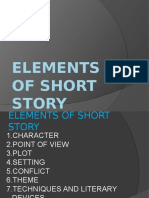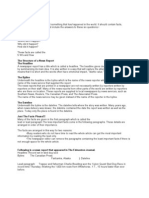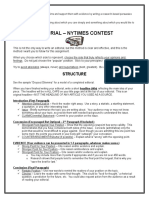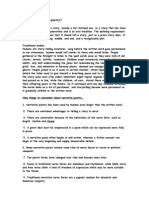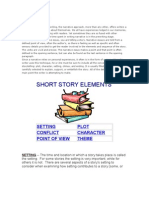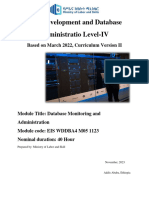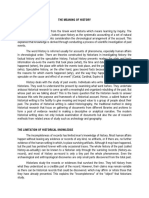Short Story Elements Handout
Short Story Elements Handout
Uploaded by
api-262266786Copyright:
Available Formats
Short Story Elements Handout
Short Story Elements Handout
Uploaded by
api-262266786Original Title
Copyright
Available Formats
Share this document
Did you find this document useful?
Is this content inappropriate?
Copyright:
Available Formats
Short Story Elements Handout
Short Story Elements Handout
Uploaded by
api-262266786Copyright:
Available Formats
SHORT STORY/NOVEL ELEMENTS
1) SETTING: The time and location in which a story takes place. For some
stories the setting is very important, while for others it is not. There are several
aspects of a story's setting to consider when examining how setting contributes to a
story (some, or all, may be present in a story:
a place ! geographical location. "here is the action of the story taking place#
b time ! "hen is the story taking place# ($istorical period, time of day, year, etc..
c weather condition ! %s it rainy, sunny, stormy, etc#
d ocial condition ! "hat is the daily life of the characters like# &oes the story
contain local colour (writing that focuses on the speech, dress, mannerisms,
customs, etc. of a particular place#
e mood or atmophere ! "hat feeling is created at the beginning of the story# %s
it bright and cheerful or dark and frightening#
!) "LOT: The plot is how the author arranges events to develop his basic idea' %t
is the se(uence of events in a story or play. The plot is a planned, logical series of
events having a beginning, middle, and end. The short story usually has one plot so
it can be read in one sitting. There are )ve essential parts of plot #ERI$ %R)&
a E'poition ! The beginning of the story, often where the characters and the
setting are introduced.
b Riin( )ction ! This is where the events in the story become complicated and
the con*ict in the story is revealed (events that lead to the climax.
c Incitin( Incident + This is usually a point of con*ict and involves a character
making an important decision that pushes the action forward and leads to the
climax.
d $lima' ! This is the highest point of interest in the story. The reader wonders
what will happen next' will the con*ict be resolved#
d %eno*ment + The events and complications begin to unravel and resolve
themselves.
e Reol*tion ! This is the )nal outcome or untangling of events in the story.
%t is helpful to consider climax as a three!fold phenomenon: , the main character
receives new information - accepts this information (reali.es it but does not
necessarily agree with it / acts on this information (makes a choice that will
determine whether or not he0she gains his ob1ective.
+) $ON,LI$T: "ithout con*ict there is no plot: it is the opposition of forces
which ties one incident to another and makes the plot move. 2on*ict is not merely
limited to open arguments' it is any form of opposition that faces the main
character. "ithin a short story there may be only one central struggle, or there may
be one dominant struggle with several minor ones.
There are two types of con*ict:
, E'ternal ! 3 struggle with a force outside oneself.
- Internal + (4motional, moral, psychological. 3 struggle within oneself' a person
must make some decision, overcome pain, (uiet their temper, resist an urge, etc.
There are four kinds of con*ict:
, "eron -. "eron (physical ! The leading character struggles with his physical
strength against other men, forces of nature, or animals.
- "eron -. $irc*mtance (classical ! The leading character struggles against
fate, or the circumstances of life facing him0her.
/ "eron -. Societ/ (social ! The leading character struggles against ideas,
practices, rules, or customs.
5 "eron -. Himel0/Herel0 (psychological ! The leading character struggles
with himself0herself' with his0her own soul, ideas of right or wrong, physical
limitations, choices, etc.
1) $H)R)$TER: There are two meanings for the word character:
, The person in a work of )ction.
- The characteristics of a person.
Persons in a work of fction ! Antagonist and Protagonist
6hort stories use few characters. 7ne character is clearly central to the story with
all ma1or events having some importance to this character ! he0she is the
897T3:7;%6T. The opposer of the main character is called the 3;T3:7;%6T.
The Characteristics of a Person -
%n order for a story to seem real to the reader its characters must seem real.
2haracteri.ation is the information the author gives the reader about the characters
themselves. The author may reveal a character in several ways:
a <77=6: his0her physical appearance
b 68442$ > T$7?:$T: what he0she says, thinks, feels and dreams
c 32T%7;6: what he0she does or does not do
d T$97?:$ 7T$496: what other characters say about and how they react to
him0her
2haracters are convincing if they are: consistent, motivated, and realistic.
Characters can be...
,. %/namic 2 developing, multi!sided personalities that change ! for better or
worse ! by the end of the story.
-. Static or ,lat ! 6tereotype, have one or two characteristics that never change
and are emphasi.ed e.g. brilliant detective, drunk, scrooge, cruel stepmother, etc.
3) "OINT O, VIE4: 8oint of view, or 8.7.@., is de)ned as the angle from which
the story is told.
,. Innocent Eye ! The story is told through the eyes of a child (his0her 1udgment
being diAerent from that of an adult .
-. Stream of Consciousness ! The story is told so that the readers feel as if they
are inside the head of one character and know all their thoughts and reactions.
/. First Person ! The story is told by the protagonist or a character who interacts
closely with the protagonist (using pronouns: %, me, we, etc.. The reader sees the
story through this person's eyes as he0she experiences it and only knows what
he0she knows or feels.
5. mniscient ! The author can narrate the story using the omniscient point of
view. 6he0he can move from character to character, event to event, having free
access to the thoughts, feelings and motivations of his characters and she0he
introduces information where and when he chooses. There are two main types of
omniscient point of view:
a mniscient !imited ! The author tells the story in third person (using pronouns
they, she, he, it, etc. "e know only what the character knows and what the author
allows him0her to tell us. "e can see the thoughts and feelings of characters if the
author chooses to reveal them to us.
b mniscient b"ecti#e + The author tells the story in the third person. %t
appears as though a camera is following the characters, going anywhere, and
recording only what is seen and heard. There is no comment on the characters or
their thoughts. ;o interpretations are oAered. The reader is placed in the position of
spectator without the author there to explain. The reader has to interpret events on
his own.
5) THEME: The theme in a piece of )ction is its controlling idea or its central
insight. %t is the author's underlying meaning or main idea that she0he is trying to
convey. The theme is often a view on human nature, or reveals a truth about society
or an individual in society. The title of the short story usually points to what the
writer is saying and she0he may use various )gures of speech to emphasi.e her0his
theme, such as: symbol, allusion, simile, metaphor, hyperbole, and0or irony.
6ome simple examples of common themes from literature, T@, and )lm are:
! Things are not always as they appear to be
! <ove and0or family prevail over all obstacles
! Believe in yourself and be true to yourself, no matter what
! 8eople are afraid of change
! Technology can push us together, but it can also pull us apart
! &on't 1udge a book by its cover
You might also like
- Ib Langlit Grade BoundariesDocument1 pageIb Langlit Grade Boundariesapi-26226678689% (9)
- Short Story Analysis TemplateDocument3 pagesShort Story Analysis Templatealaizamarief100% (3)
- Short Story Analysis TemplateDocument2 pagesShort Story Analysis Templatedi compendio67% (3)
- A Contract Overseas EssayDocument2 pagesA Contract Overseas EssayPeter Louise D. Garnace100% (2)
- An Introduction To Poetry - UpdatedDocument55 pagesAn Introduction To Poetry - Updatedapi-262266786100% (2)
- Paper 1 SL TipsDocument1 pagePaper 1 SL Tipsapi-262266786No ratings yet
- Textual Analysis in 3 Steps - ChartDocument2 pagesTextual Analysis in 3 Steps - Chartapi-262266786No ratings yet
- Lesson 1 ELEMENTS OF SHORT STORYDocument30 pagesLesson 1 ELEMENTS OF SHORT STORYEdson GarciaNo ratings yet
- Sample Annotated Text: Ear EditorDocument1 pageSample Annotated Text: Ear EditorDaewoo100% (2)
- Drama: The Origin and Elements of A Good DramaDocument5 pagesDrama: The Origin and Elements of A Good DramaEmjhay Swakida100% (1)
- Short Story and The Elements of A Short StoryDocument3 pagesShort Story and The Elements of A Short StoryA C50% (2)
- Paper 1 Comparative Commentary HLDocument1 pagePaper 1 Comparative Commentary HLapi-26226678683% (6)
- Comparative Textual AnalysisDocument3 pagesComparative Textual Analysisapi-262266786100% (5)
- p2 Bell Jar and Dolls HouseDocument4 pagesp2 Bell Jar and Dolls Houseapi-262266786100% (1)
- Literary Analysis Essay - Response To Lit Essay Shorter VersionDocument2 pagesLiterary Analysis Essay - Response To Lit Essay Shorter Versionapi-262266786100% (1)
- Genre Sub-Genre Elements StructureDocument4 pagesGenre Sub-Genre Elements StructureAndrea IbañezNo ratings yet
- Elements of PoetryDocument13 pagesElements of PoetryMyrene Ariculo SebuhaNo ratings yet
- Module 2.3 - PROSEDocument13 pagesModule 2.3 - PROSEFernan CapistranoNo ratings yet
- Film GenresDocument5 pagesFilm GenresAizel Nova Fermilan Arañez100% (1)
- Short Story CritiqueDocument3 pagesShort Story CritiqueKimberly Bautista50% (2)
- Feminist Criticism of ZootopiaDocument3 pagesFeminist Criticism of ZootopiaJovelyn orateNo ratings yet
- Story of KeeshDocument5 pagesStory of KeeshMONEL CHUA100% (2)
- Activity in Module 5-BSEE34-MirandaDocument6 pagesActivity in Module 5-BSEE34-MirandaAiza A. MirandaNo ratings yet
- What Is A News ReportDocument2 pagesWhat Is A News ReportrajilogNo ratings yet
- TEACHING READING AND GRAMMAR Lesson PlaDocument16 pagesTEACHING READING AND GRAMMAR Lesson PlaVcra GenevieveNo ratings yet
- A Formalistic Analysis of The Short Story Dog EatersDocument1 pageA Formalistic Analysis of The Short Story Dog EatersRefashe English50% (2)
- Plot - Elements of Plot StructureDocument3 pagesPlot - Elements of Plot StructurenettextsNo ratings yet
- Structure and PoetryDocument13 pagesStructure and PoetrySherwinNo ratings yet
- Steps in Planning and Drafting Your Speech: Type Equation HereDocument2 pagesSteps in Planning and Drafting Your Speech: Type Equation HereJemima Camilosa ClomaNo ratings yet
- Textual AidsDocument23 pagesTextual AidsJoan GozonNo ratings yet
- Editorial StructureDocument4 pagesEditorial StructureAmirtha Krish100% (1)
- Terminologies Used in Basketball and VolleyballDocument3 pagesTerminologies Used in Basketball and VolleyballArmen GuadaniaNo ratings yet
- 21st Century Literature by Isagani Cruz (With Questions)Document4 pages21st Century Literature by Isagani Cruz (With Questions)Mycel BalmesNo ratings yet
- Speculativ E Fiction: Group 2Document28 pagesSpeculativ E Fiction: Group 2qwertasdfgNo ratings yet
- Pedro PendukoDocument5 pagesPedro PendukoCris LuNo ratings yet
- Lesson3 StaticdynamicDocument2 pagesLesson3 StaticdynamicApriljay Celada SemenseNo ratings yet
- Short Story Rubric 2Document1 pageShort Story Rubric 2Laila KamarudinNo ratings yet
- WORKSHEET (Elements of Drama) : Death of A Salesman, Act 1Document2 pagesWORKSHEET (Elements of Drama) : Death of A Salesman, Act 1JenivanValezaAvila50% (2)
- English 10 Module - Q1-Week 1-2Document16 pagesEnglish 10 Module - Q1-Week 1-2Angelica Javillonar AngcoyNo ratings yet
- Historical ApproachDocument9 pagesHistorical ApproachrexNo ratings yet
- Formalism Critique PaperDocument4 pagesFormalism Critique PaperJanine Andrea BuhainNo ratings yet
- Stylistic AnalysisDocument9 pagesStylistic Analysisere chan100% (1)
- The Tale of Tonyo The Brave...Document4 pagesThe Tale of Tonyo The Brave...Joshua Nathaniel MondejarNo ratings yet
- Analyzing A Movie Entitled, "Hello, Love, Goodbye" Using Mise-En-Scene ApproachDocument6 pagesAnalyzing A Movie Entitled, "Hello, Love, Goodbye" Using Mise-En-Scene ApproachJhet Ambrose DasmariñasNo ratings yet
- Readers Theater Chamber Theater and One Act PlayDocument42 pagesReaders Theater Chamber Theater and One Act PlayAliza Jean Delarosa BuenafeNo ratings yet
- Effective Communication ProcessDocument24 pagesEffective Communication ProcessDan JamesNo ratings yet
- Writing A Close Analysis and Critical Interpretation of Literary Texts Applying A Reading Approach - DelicaDocument2 pagesWriting A Close Analysis and Critical Interpretation of Literary Texts Applying A Reading Approach - DelicaClive MorrisNo ratings yet
- "Look Deep Into Nature, and Then You Will Understand Everything Better." - Albert EinsteinDocument20 pages"Look Deep Into Nature, and Then You Will Understand Everything Better." - Albert EinsteinRickyJecielNo ratings yet
- Life of Pi (Reaction Paper)Document2 pagesLife of Pi (Reaction Paper)SabNo ratings yet
- Is Global Solidarity PossibleDocument4 pagesIs Global Solidarity PossibleNeil Joseph Alcala75% (4)
- Literary LensesDocument20 pagesLiterary LensesKheal Mata100% (1)
- Five Brothers, One MotherDocument1 pageFive Brothers, One MotherDecks Yu100% (1)
- Reader's Response Criticism On Kate ChopinDocument2 pagesReader's Response Criticism On Kate Chopinnepen the100% (1)
- Personal DevelopmentDocument13 pagesPersonal DevelopmentDonquixote MingoNo ratings yet
- The Filipino Poetry: Filipino Poetry Forms in The 21st Century Guidelines in Poetry Analysis Elements of PoetryDocument18 pagesThe Filipino Poetry: Filipino Poetry Forms in The 21st Century Guidelines in Poetry Analysis Elements of PoetrySarah SamonNo ratings yet
- "Coraline": A Novella by Neil GaimanDocument7 pages"Coraline": A Novella by Neil GaimanAj RoselNo ratings yet
- 21 Century: 1 QuarterDocument48 pages21 Century: 1 QuarterCarla VillamorNo ratings yet
- Waiting by Ron DarvinDocument9 pagesWaiting by Ron DarvinJonah Mae SiguaNo ratings yet
- English 10Document2 pagesEnglish 10Jio SandagNo ratings yet
- The Oracle Given To King Acrisius Will Be Fulfilled by His GrandsonDocument2 pagesThe Oracle Given To King Acrisius Will Be Fulfilled by His GrandsonAva BarramedaNo ratings yet
- A Day in The CountryDocument7 pagesA Day in The CountryGreg ManNo ratings yet
- 9 A Journey Through Anglo American Literature Module 1 PDFDocument145 pages9 A Journey Through Anglo American Literature Module 1 PDFAnonymous nMG8p5E1100% (1)
- 2nd Grading RevisedDocument41 pages2nd Grading RevisedFatima ButilNo ratings yet
- What Is Narrative PoetryDocument1 pageWhat Is Narrative PoetryemilyjaneboyleNo ratings yet
- Elements of A Short StoryDocument4 pagesElements of A Short StoryA C100% (1)
- KeeshpptDocument24 pagesKeeshpptLuke PettNo ratings yet
- Six Elements of FictionDocument4 pagesSix Elements of FictionJaenal MutaqinNo ratings yet
- Narrative EssayDocument5 pagesNarrative Essaysunshinebaby19840% (1)
- Further Oral Activity - Foa Proposal: PROPOSAL: Questions To AnswerDocument1 pageFurther Oral Activity - Foa Proposal: PROPOSAL: Questions To Answerapi-262266786No ratings yet
- An Introduction To PoetryDocument54 pagesAn Introduction To Poetryapi-262266786100% (1)
- I.O.C Format For Literary Passage - One ApproachDocument1 pageI.O.C Format For Literary Passage - One Approachapi-262266786No ratings yet
- Steps To The Ioc Paper 1 - With VisualDocument1 pageSteps To The Ioc Paper 1 - With Visualapi-262266786No ratings yet
- Possible Template Ioc Commentary HughesDocument2 pagesPossible Template Ioc Commentary Hughesapi-262266786100% (2)
- DP Written Task BookletDocument14 pagesDP Written Task Bookletapi-262266786100% (1)
- Part 2 Book Review PDFDocument1 pagePart 2 Book Review PDFapi-262266786No ratings yet
- The Compare and Contrast EssayDocument3 pagesThe Compare and Contrast Essayapi-262266786100% (1)
- ElementsofFiction6 4 10Document21 pagesElementsofFiction6 4 10Adina CalugaruNo ratings yet
- Text Type Intro Presentation TaskDocument1 pageText Type Intro Presentation Taskapi-262266786100% (1)
- PoeticformsDocument3 pagesPoeticformsapi-262266786No ratings yet
- Crafting Your Thesis StatementDocument1 pageCrafting Your Thesis Statementapi-262266786No ratings yet
- CharacterworksheetupdatedDocument1 pageCharacterworksheetupdatedapi-262266786No ratings yet
- Writing A Textual Analysis ChartDocument2 pagesWriting A Textual Analysis Chartapi-262266786No ratings yet
- Analysing An Image - One PageDocument1 pageAnalysing An Image - One Pageapi-262266786No ratings yet
- Sample Foa Language Cultural ContextDocument2 pagesSample Foa Language Cultural Contextapi-262266786100% (1)
- Visual Literacy - Design ElementsDocument3 pagesVisual Literacy - Design Elementsapi-262266786100% (2)
- Thesis Statements - What How Why So WhatDocument1 pageThesis Statements - What How Why So Whatapi-262266786No ratings yet
- Paper 1 HL Comparative-Commentary Structure and SampleDocument8 pagesPaper 1 HL Comparative-Commentary Structure and Sampleapi-262266786100% (4)
- Paper 2 Introduction PDFDocument2 pagesPaper 2 Introduction PDFapi-262266786100% (2)
- Language A English: Language and Literature (SL) DP1 Tips For A Successful Textual AnalysisDocument2 pagesLanguage A English: Language and Literature (SL) DP1 Tips For A Successful Textual AnalysisSarthak GuptaNo ratings yet
- Introduction To Literary CriticismDocument31 pagesIntroduction To Literary Criticismapi-262266786100% (4)
- LaravelsaasDocument120 pagesLaravelsaasLuz DeMars100% (1)
- Dsa Lesson PlanDocument7 pagesDsa Lesson Planapi-284091048No ratings yet
- Solving PDEs in Python The FEniCS Tutorial I (Hans Petter Langtangen, Anders Logg) (Z-Library) - Pages-2Document51 pagesSolving PDEs in Python The FEniCS Tutorial I (Hans Petter Langtangen, Anders Logg) (Z-Library) - Pages-2Daniel KashalaNo ratings yet
- Coding Test AnswerDocument9 pagesCoding Test Answerprince keshriNo ratings yet
- SSIS: File System Task Move and Rename Files in One StepDocument8 pagesSSIS: File System Task Move and Rename Files in One Stepn2bhukyaNo ratings yet
- My ResumeDocument1 pageMy Resumesushmitasarkar242No ratings yet
- TM05 Monitor and Administer DatabaseDocument50 pagesTM05 Monitor and Administer DatabaseCherinet dubaleNo ratings yet
- Customs of The Tagalogs: Juan de PlasenciaDocument19 pagesCustoms of The Tagalogs: Juan de PlasenciatineNo ratings yet
- XK3118T1 Operation ManualDocument10 pagesXK3118T1 Operation ManualGerardo RodriguezNo ratings yet
- Exercise On Simple PastDocument4 pagesExercise On Simple PastMaria SanchezNo ratings yet
- DKKDocument99 pagesDKKindra abadiNo ratings yet
- Winols Manual PDFDocument125 pagesWinols Manual PDFxivo5100% (2)
- STSR HandbookDocument8 pagesSTSR HandbookWang SimengNo ratings yet
- Inglés Instrumental: Unit 4. Modal VerbsDocument6 pagesInglés Instrumental: Unit 4. Modal Verbsclaudia100% (2)
- Motivation Letter Paula PuntoDocument1 pageMotivation Letter Paula PuntoSanty CasalNo ratings yet
- CSS-FW.L.U01 (Boostrap 4)Document71 pagesCSS-FW.L.U01 (Boostrap 4)beu24122000No ratings yet
- The Meaning of History, Sources of Historical Data and Historical Criticism (Notes)Document7 pagesThe Meaning of History, Sources of Historical Data and Historical Criticism (Notes)Ebab YviNo ratings yet
- Rest ApiDocument22 pagesRest ApiPraveen Negi100% (2)
- Lesson 1 Text As Connected DiscourseDocument2 pagesLesson 1 Text As Connected DiscourseLaisa MercadoNo ratings yet
- Redesign of The Linux Driver For The Mesa Anything IO Cards.Document24 pagesRedesign of The Linux Driver For The Mesa Anything IO Cards.joseNo ratings yet
- Bookxcess Book Order List 2022Document179 pagesBookxcess Book Order List 2022LyaNo ratings yet
- Fetch and Open Cursor AnalysisDocument34 pagesFetch and Open Cursor Analysisruki100% (1)
- Revision Notes - 23 Data Transmission TechnologiesDocument15 pagesRevision Notes - 23 Data Transmission TechnologiesMugerwa CharlesNo ratings yet
- An Extremely Powerful Invocation For Daily Use and WorkDocument2 pagesAn Extremely Powerful Invocation For Daily Use and WorkJoseph Kanyi100% (1)
- Word 2016 Full NoteDocument80 pagesWord 2016 Full Noteyazdialam475No ratings yet
- Barrycades and SeptokuDocument236 pagesBarrycades and SeptokuHuseyn Huseynli100% (1)
- Mt6577 CWMR Root Updated v2Document35 pagesMt6577 CWMR Root Updated v2Javi Kruztaceo Kruz0% (1)
- Lesson Plan - Making RequestsDocument8 pagesLesson Plan - Making RequestsAizhamal BagytovaNo ratings yet
- Web Design For Beginners - Project BriefDocument19 pagesWeb Design For Beginners - Project BriefMouhamed Nazirou DiankhaNo ratings yet
- DiscussionDocument7 pagesDiscussionCosmin TudoseNo ratings yet







